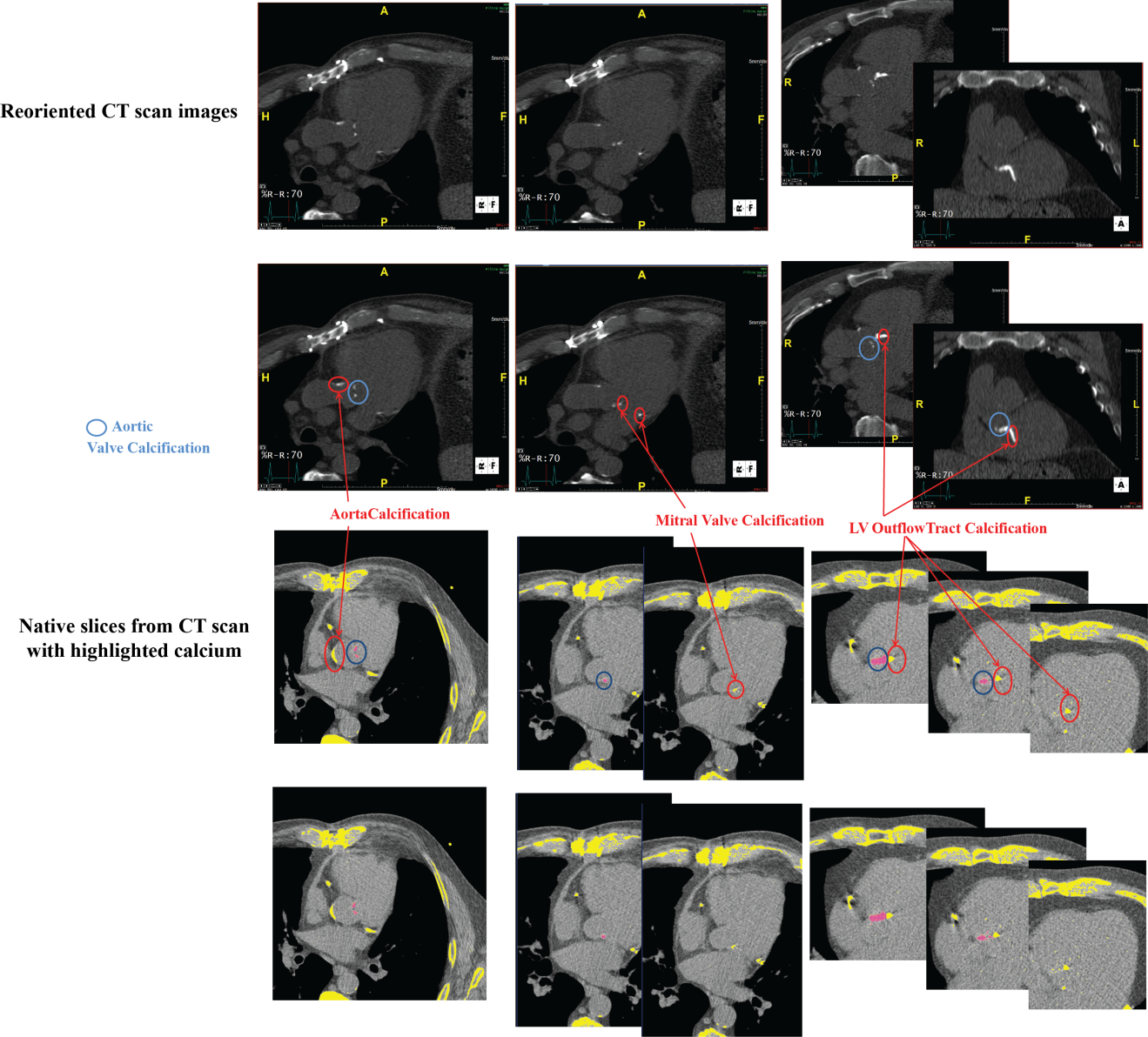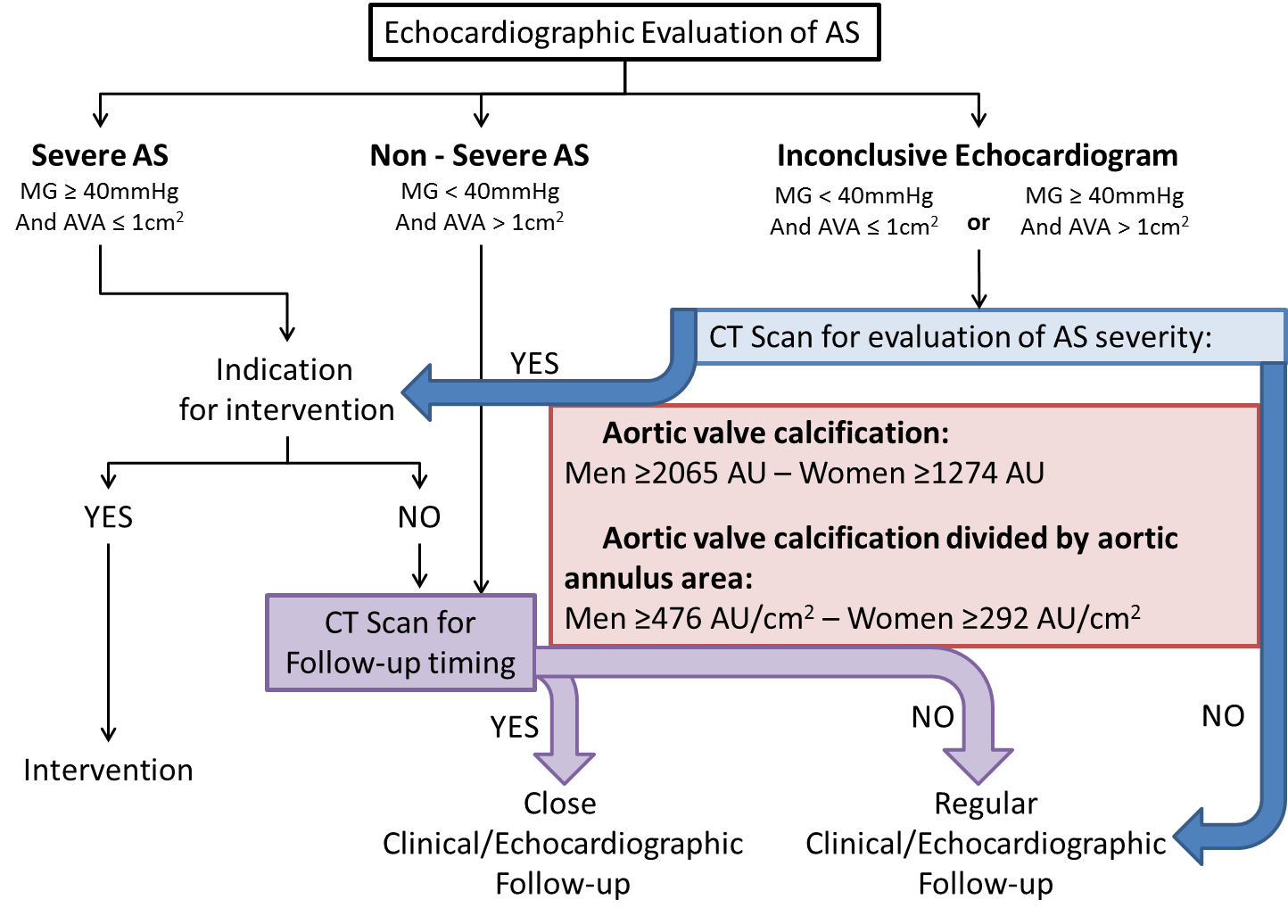How Does CT Fit Into the Evaluation and Management of Patients With AS?
Aortic stenosis (AS) etiology, in western country, is nowadays principally degenerative with calcium deposition in aortic valve leaflets. It has long been known that moderate/severe aortic valve calcification (AVC), as documented by Doppler echocardiography, is a predictor of worse outcome in patients with AS.1 However, echocardiography is based on semi-quantitative assessment and allows only an imprecise evaluation of AVC load.2 Although Doppler echocardiography is the first line for the hemodynamic evaluation of AS severity, computed tomography (CT) may provide important complementary information in the evaluation and management of patients with AS.
CT has been shown to provide accurate and reproducible measurement of calcification load in the aortic valve.2,3 AVC is measured on non-contrast, non-reconstructed CT scans during trained end-inspiration breath-hold (Figure 1), with the use of the Agatston method, described for coronary artery calcification evaluation.4 Nowadays, multidetector CT scans are generally used and parameterized with 30-80 mA and 120-130 kV, depending on prospective or retrospective gating at 70-80% of the R-R interval. Calcification is defined as 4 adjacent pixels with density >130 Hounsfield units and can be easily measured with commercially available software. The region of the aortic valve should be delimited with caution in order to avoid inclusion of calcifications in the wall of the aorta, the left ventricle outflow tract (LVOT), and/or the annulus of the mitral valve (Figure 1).
Figure 1: CT Images With and Without Highlighted Calcification
AVC load has been shown to be a predictor of death and adverse events in AS even after adjustment for hemodynamic severity of AS (i.e., aortic valve area [AVA], peak aortic jet velocity, and/or mean gradient).2,5 Mortality in patients with severe AVC was largely alleviated by aortic valve replacement, demonstrating that the link between AVC and death was largely dependent on AS.5 Moreover, some studies demonstrated that AVC measured by CT is a major predictor of anatomic and hemodynamic progression of AS.6-8 Hence, in patients with no indication for aortic valve replacement (i.e., hemodynamically non-severe and/or asymptomatic AS), AVC can be used to identify patients who are at higher risk for rapid AS progression and therefore adapt the time interval between follow-up visits. Patients with severe AVC will progress more rapidly and have higher risk for aortic valve replacement or death and should thus have closer follow-up than patients with non-severe calcification (Figure 2).
Figure 2: Integration of CT in Evaluation and Management of Patients With AS
In patients with an inconclusive echocardiographic exam, such as discordance between gradient and AVA, measurement of AVC by CT may be useful to corroborate AS severity. Indeed, AVC is well-correlated with hemodynamic severity of AS. However, this relationship is different between men and women.3 Women reach a more severe AS for similar AVC load, even after adjustment for body surface area or aortic annulus area.3,9 Thus cut-point values defining severe AS have to be different in men and women (Table 1-Figure 2). These cut-points provide a specificity to detect hemodynamically severe AS higher than 80% and a sensitivity higher than 80% for non-indexed AVC and higher than 90% for AVC indexed to aortic annulus area.9 AVC measurement may be useful to identify severe AS, especially in patients with low-flow, low-gradient AS with or without decreased left ventricular ejection fraction (LVEF). In patients with low-flow, low-gradient AS and reduced LVEF, dobutamine stress echocardiography is recommended to assess AS severity and flow reserve.10 However, in patients without flow reserve, AS severity cannot be confirmed by dobutamine stress echocardiography or catheterization.11,12 In these patients, quantitation of AVC by CT is the most reliable assessment of AS severity. In patients with low-flow, low-gradient AS and preserved LVEF, stress echocardiography has been proposed to assess AS severity,13 and exercise stress echocardiography is useful in asymptomatic patients or in patients with equivocal symptoms to confirm symptomatic status. However, in symptomatic patients, exercise stress echocardiography is contraindicated, and dobutamine stress echocardiography should not be performed in patients with restrictive left ventricle physiology pattern. Thus, AVC could be the method of choice to assess AS severity in this context. Finally, in patients with low-gradient, normal-flow AS with small AVA and normal LVEF, the use of stress echocardiography to increase the flow would probably not help assess AS severity given that patients already have a normal flow. Although these patients with normal-flow, low-gradient AS are considered as patients with progressive AS in the 2014 ACC/AHA guidelines,10 several studies and a recent meta-analysis demonstrated that about half of these patients have severe AS on the basis of AVC and that these patients may benefit from aortic valve replacement.9,14 Thus, the use of AVC in symptomatic patients with low gradient and small AVA may help in clinical decision-making. Aortic valve replacement should probably be considered in these patients if severe valve calcification is present (Figure 2).
Table 1: Cut-Points and Accuracy of AVC and AVC Divided by Aortic Annulus Area to Identify Severe AS9
Variable |
Sex |
Area Under the Curve |
Cut-Points |
Sensitivity (%) |
Specificity (%) |
AVC |
Women |
0.91 |
1,274 arbitrary unit (AU) |
86 |
89 |
Men |
0.90 |
2,065 AUt |
89 |
80 |
|
AVC Density* |
Women |
0.93 |
292 AU/cm2 |
92 |
81 |
Men |
0.92 |
476 AU/cm2 |
90 |
80 |
In these patients with low gradient despite a tight AVA, the issue of non-circular LVOT has often been suspected as the reason for gradient-valve area discrepancy, especially when velocity ratio at echocardiography does not indicate severe AS (i.e., velocity time integral in LVOT divided by velocity time integral in the aorta >0.25). Numerous studies demonstrated that when assessed by three-dimensional-modality imaging (three-dimensional echocardiography or CT), LVOT area was always larger than when assessed by two-dimensional echocardiography, thus indicating an underestimation of AVA as calculated with the use of two-dimensional echocardiography. However, when compared with direct operative measurement of LVOT, CT has been shown to overestimate LVOT area.15 Moreover, AVA calculated with the use of LVOT measured by CT did not predict survival better, and the threshold to define severe AS was larger (i.e., 1.2 cm2 vs. 1.0 cm2 when AVA was calculated by two-dimensional echocardiography).16 Furthermore, measurement of LVOT by CT requires the use of contrast, which may be deleterious for patients with renal failure. Thus, the use of CT for LVOT measurement should not be used for routine assessment of AS severity and be reserved for pre-transcatheter aortic valve implantation evaluation.
In conclusion, in the evaluation and management of patients with AS, CT has an important role for the quantitation of AVC load in order to assess AS severity in patients with inconclusive echocardiographic findings, especially those with discordance between a low gradient and a tight AVA, with or without low flow/ejection fraction. In analyzing AVC load, sex-specific thresholds have to be used given that women reach a more hemodynamically severe AS than men for the same amount of valve calcification. AVC load evaluation may also be useful to assess the risk of rapid AS progression and, therefore, adjust the timing of follow-up for patients without an indication for surgery.
References
- Rosenhek R, Binder T, Porenta G, et al. Predictors of outcome in severe, asymptomatic aortic stenosis. N Engl J Med 2000;343:611-7.
- Messika-Zeitoun D, Aubry MC, Detaint D, et al. Evaluation and clinical implications of aortic valve calcification measured by electron-beam computed tomography. Circulation 2004;110:356-62.
- Aggarwal SR, Clavel MA, Messika-Zeitoun D, et al. Sex differences in aortic valve calcification measured by multidetector computed tomography in aortic stenosis. Circ Cardiovasc Imaging 2013;6:40-7.
- Agatston AS, Janowitz WR, Hildner FJ, Zusmer NR, Viamonte M Jr, Detrano R. Quantification of coronary artery calcium using ultrafast computed tomography. J Am Coll Cardiol 1990;15:827-32.
- Clavel MA, Pibarot P, Messika-Zeitoun D, et al. Impact of aortic valve calcification, as measured by MDCT, on survival in patients with aortic stenosis: results of an international registry study. J Am Coll Cardiol 2014;64:1202-13.
- Messika-Zeitoun D, Bielak LF, Peyser PA, et al. Aortic valve calcification: determinants and progression in the population. Arterioscler Thromb Vasc Biol 2007;27:642-8.
- Nguyen V, Cimadevilla C, Estellat C, et al. Haemodynamic and anatomic progression of aortic stenosis. Heart 2015;101:943-7.
- Tastet L, Capoulade R, Clavel MA, et al. Systolic hypertension and progression of aortic valve calcification in patients with aortic stenosis: results from the PROGRESSA study. Eur Heart J Cardiovasc Imaging 2016 Feb 18 [Epub ahead of print].
- Clavel MA, Messika-Zeitoun D, Pibarot P, et al. The complex nature of discordant severe calcified aortic valve disease grading: new insights from combined Doppler echocardiographic and computed tomographic study. J Am Coll Cardiol 2013;62:2329-38.
- Nishimura RA, Otto CM, Bonow RO, et al. 2014 AHA/ACC guideline for the management of patients with valvular heart disease: a report of the American College of Cardiology/American Heart Association Task Force on Practice Guidelines. J Am Coll Cardiol 2014;63:e57-185.
- Blais C, Burwash IG, Mundigler G, et al. Projected valve area at normal flow rate improves the assessment of stenosis severity in patients with low-flow, low-gradient aortic stenosis: the multicenter TOPAS (Truly or Pseudo-Severe Aortic Stenosis) study. Circulation 2006;113:711-21.
- Clavel MA, Burwash IG, Mundigler G, et al. Validation of conventional and simplified methods to calculate projected valve area at normal flow rate in patients with low flow, low gradient aortic stenosis: the multicenter TOPAS (True or Pseudo Severe Aortic Stenosis) study. J Am Soc Echocardiogr 2010;23:380-6.
- Clavel MA, Ennezat PV, Maréchaux S, et al. Stress echocardiography to assess stenosis severity and predict outcome in patients with paradoxical low-flow, low-gradient aortic stenosis and preserved LVEF. JACC Cardiovasc Imaging 2013;6:175-83.
- Dayan V, Vignolo G, Magne J, Clavel MA, Mohty D, Pibarot P. Outcome and Impact of Aortic Valve Replacement in Patients With Preserved LVEF and Low-Gradient Aortic Stenosis. J Am Coll Cardiol 2015;66:2594-603.
- Kempfert J, Van Linden A, Lehmkuhl L, et al. Aortic annulus sizing: echocardiographic versus computed tomography derived measurements in comparison with direct surgical sizing. Eur J Cardiothorac Surg 2012;42:627-33.
- Clavel MA, Malouf J, Messika-Zeitoun D, Araoz PA, Michelena HI, Enriquez-Sarano M. Aortic valve area calculation in aortic stenosis by CT and Doppler echocardiography. JACC Cardiovasc Imaging 2015;8:248-57.
Keywords: Aorta, Aortic Valve, Aortic Valve Stenosis, Body Surface Area, Calcinosis, Catheterization, Coronary Vessels, Echocardiography, Echocardiography, Doppler, Echocardiography, Stress, Echocardiography, Three-Dimensional, Heart Ventricles, Mitral Valve, Renal Insufficiency, Stroke Volume, Tomography, Tomography, X-Ray Computed, Transcatheter Aortic Valve Replacement
< Back to Listings


